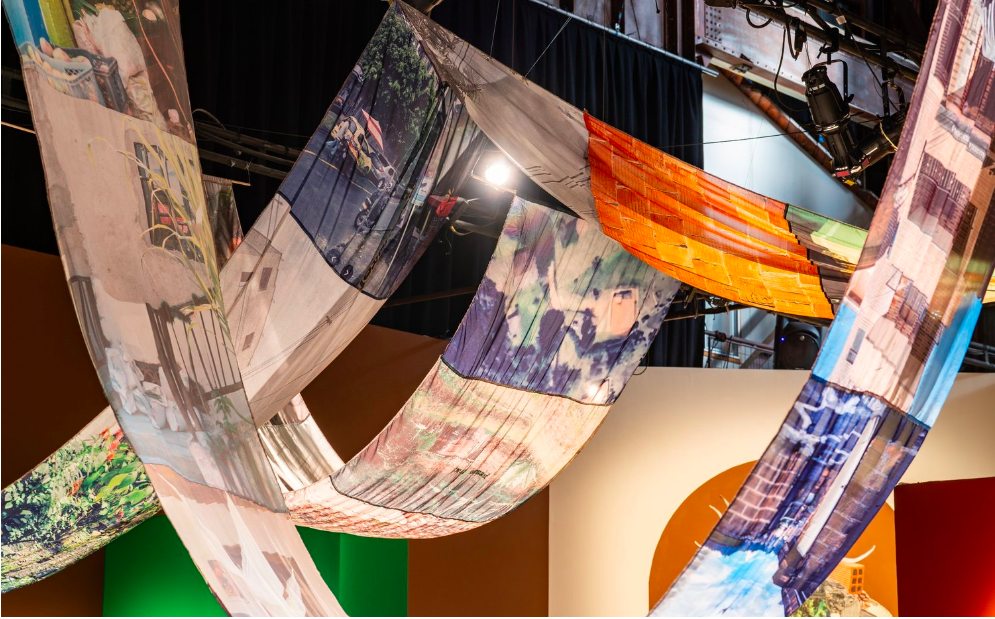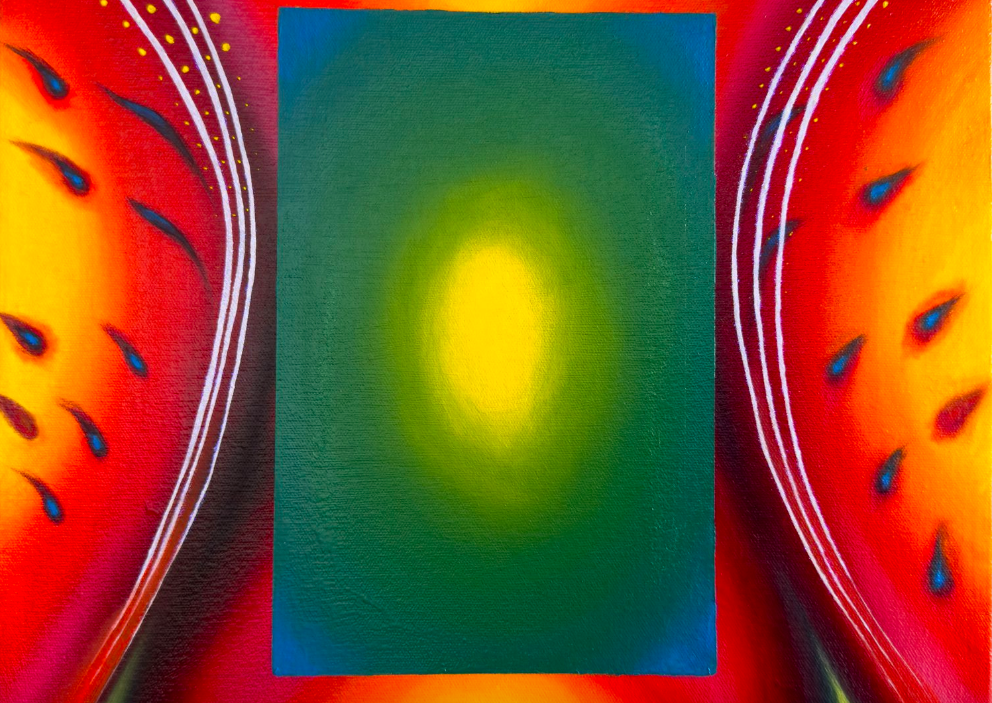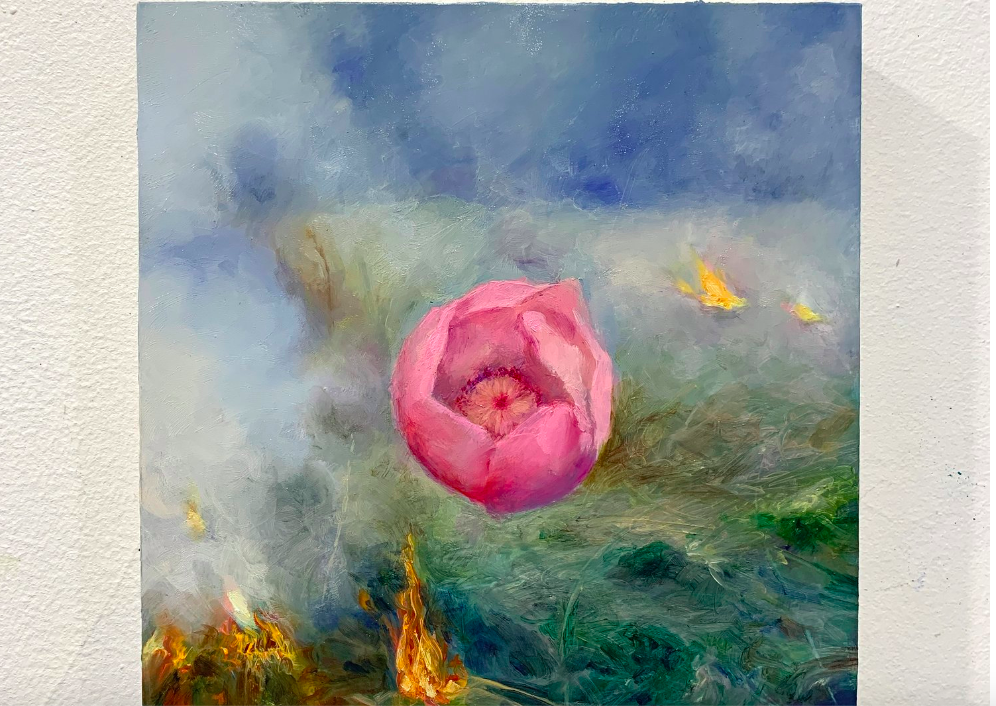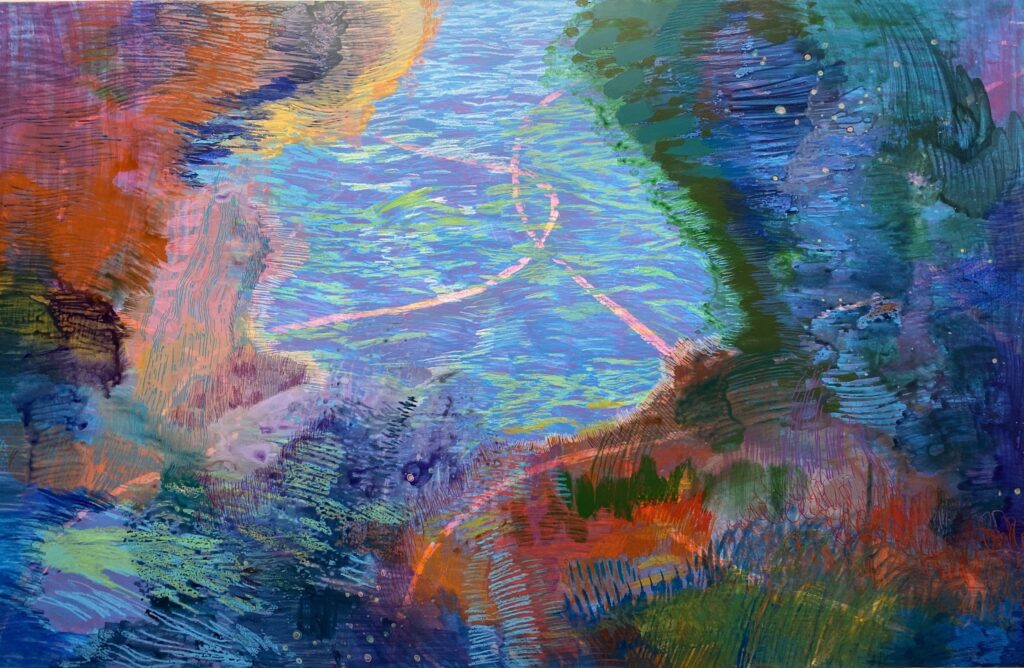“The Psychic Landscape” Explores Meaning Beyond Our Surroundings

Having recently opened on February 1st at the NYC Culture Club, The Psychic Landscape showcases the work of five Latinx artists Paola de la Calle, Francisco Donoso, Kathryn Godoy, Elsa Muñoz, and Marisol Ruiz. Co-curated by artist Francisco Donoso and art advisor and communications specialist Veronica Petty, this exhibition re-imagines the definition of landscape as more than just the physical environment that surrounds us. The Psychic Landscape explores the in-between, the connection between memory and what’s happening now, identity, interiority, and temporality.

“By exploring the “in-between” and the intimate meditation of memory, these elements have influenced the emotional landscape of my paintings, inviting viewers to explore the nuanced spaces between reality, memory, and imagination. A center of focus is that I study how memories change. Each memory is a memory of a memory. The paintings in The Psychic Landscape serve as windows into these in-between realms, encouraging contemplation of memory’s fluid and dynamic nature and its emotional impact.”
Marisol Ruiz as told to co-curators Francisco Donoso and Veronica Petty
Let’s dive in! Veronica, you and co-curator Francisco Donoso have known each other for awhile and have worked together in the past. Veronica, your firm Domingo Comms, is a one-stop shop for PR, art advisory, exhibition planning, and more. Domingo also focuses on providing a platform for Latinx artists, expanding their reach through in-person showcases and online platforms.
Francisco, I have had the pleasure of meeting you a few times and we even got to do a wonderful studio visit. You are well known for your mixed media paintings that are bursting with color. However, a lot is going on beneath the surface as your work explores tough subjects including identity, immigration, physical borders and separation. As a DACA recipient, you’ve reclaimed your power and identity by re-envisioning the chain-link fence as something that is not a physical barrier meant to keep people out.
How did this exhibition come together? Were you both already familiar with the other artists who are part of the show?
FD: We both kept having conversations about artists that we are interested in currently, or have been for a long time, and as this opportunity emerged we found a way to piece them together in the exhibition. The themes of migration and spirituality are ones that we share, so the exhibition came about rather easily.
VP: Francisco, Paola, and Kathryn have been part of Domingo Comms for a while and it was always our plan to find more opportunities to put their work into dialogue. We were both massive fans of Marisol and after visiting her studio we learned that she was interested in pushing her work further into abstraction, which was really inspiring to us. Our admiration for Elsa’s work came up in conversation one day over brunch at my house after we had already sent in a proposal for a different NYC Culture Club space. When the venue changed, it felt meant to be to include her work and it absolutely was.

“I keep thinking about the book The Body Keeps the Score [by Bessel van der Kolk], which talks about how trauma lives in our physical bodies. That lens shapes my understanding that the earth is a body and we are many bodies within that large body.”
Elsa Munoz as told to Francisco Donoso and Veronica Petty
Curating a group show and coming up with a theme that makes sense for all the artists involved is no easy feat! Did you already have the theme in mind before selecting the artists?
FD: What was most important to us was to start with artists that we felt strongly about and then slowly find the threads that connected them, myself included. We did not embark on this project knowing the title or theme first and then looking for artists that fit the description but rather centered the project on the works we loved and admired. The excitement of realizing how interconnected everyone actually is just confirmed our initial gut feelings about the project and we took it as a sign to keep going.
VP: Certain works from each artist anchored our focus – Kathryn’s ‘a moon so bright I cannot see my shadow,’ Paola’s ‘Hanging Archive,’ and, of course, Francisco’s body of work, creating these expansive abstract landscapes. All the artists work in this poetic terrain across their practices, which is super interesting. Elsa and Marisol, again like all the artists, share this deep connection to spirituality, using color to express the otherworldly in their work. The works blur the lines of memory and reality, which, for us, is fascinating on many levels. As people with roots in Latin America, somewhere else – it does not matter where – there is recognition, even when the works are abstracted.

“So in my practice I’m threading together the past and present to better understand the socio-political relationship between two countries I call home, to better understand myself, and to contextualize the family stories that make their way into my art. In “Todo El Cielo Cabe En Una Maleta” (or “The Whole Sky Fits in a Suitcase’”) I’m exploring the idea of “envios” or “encargos”, but I’m not just exploring the material goods we send across borders, but the intangible as well. The embroidered text on the suitcase reads: In my dreams I visit places that no longer exist and I wonder if you visit them too and if so are dreams memories too?”
-Paola de Calle as told to Francisco Donoso and Veronica Petty
After reading the press release, I was really struck by this: “Through a variety of visual strategies and mediums, they embark on a journey through imagined spaces.” I’d love to unpack this a bit more.
FD: The psychic spaces of memory, storytelling, and longing are mediated by the representation of nature in some cases, or abstract coloration in others, which reveal the depths and complexities of the artists’ curiosities and pursuits. I think artists like myself and Elsa are looking at the spiritual potential inherent in nature, and so we represent it to some extent, while artists like Marisol and Kathryn use color, form and repetition to suggest spaces that feel cavernous, airy and ethereal. Paola references very specific places, like Colombia, but manipulates the printed images as a way of rupturing their reference and opening them up to new possible meanings.
VP: The artists’ visual strategies have really come to the forefront of the exhibition because of just how precise each artist is with their medium choices, motifs, and techniques – all their works contain such specific messages, and often their own ‘visual language.’ For example, Elsa’s flames in her Controlled Burning series convey the idea that something as seemingly hostile as fire can be used as a tool for health and regrowth. Marisol’s use of color serves as a vehicle to transport her to memories of growing up in rural Puerto Rico. Kathryn’s paper works, which are often large, fragile pieces sometimes painted on both sides, are transformed into art objects through the act of painting. Paola attaches meaning to objects and the mediums she works with – printmaking is political, coffee evokes memories of home, and iron refers to memory or ephemerality. Francisco incorporates a chain-link fence motif into his work, using it to reference not only his identity as an undocumented immigrant in the US but also larger themes of migration, limitations, and power structures.

“The natural world, including the cosmos, are deeply significant and spiritual to me. The moon phase I use as a symbol of something transformative and cyclical, stars as something to wish on, to reach for. We all live under these celestial bodies, to me they offer an entryway to a connection to the mystery and vastness of life.”
-Kathryn Godoy as told to co-curators Francisco Donoso and Veronica Petty
I read the Refinery29 article about Paola de Calle’s decision to only use photographs, Google Maps images, and video stills in In This House We are All Buried Alive. This decision stems from her (incredibly understandable fear) of abandonment and anxiety that immigration officers could come at any moment to detain and deport all the adults in her life. While no two experiences are alike, Francisco I’m curious to hear from your perspective if your decision to paint chain-link fences versus incorporating photos of the actual border fences comes from a similar place?
FD: I’m interested in the chain-link fence as a way to represent more than just borders, because it’s such a ubiquitous image that has come to symbolize so much. Recently I’ve been thinking of the fence in my work as the presence of inescapable grief that I (and many) are currently experiencing as we watch genocide take place. The very real human loss that gets transmitted to the US via media like images and videos becomes ingrained in my psyche, and becomes the grief that lingers like a cloud. In general, I’m more interested in exploring the less obvious experiences of migration, which are sometimes the ones that have the most impact- particularly the stuff that gets buried deep within the mind and repressed.

-Francisco Donoso as told to Veronica Petty
“I use the chain-link fence in my work to reference not only my identity as an undocumented immigrant in the US, but larger themes of migration, limitations and power structures. The fence appears like a ghost, a memory, or an ever-looming cloud in the work, sometimes disappearing completely behind other layers, and later re-emerging quietly. I want the presence of the fence to remain, while not becoming the only protagonist in the works. The imprints left upon our psyche by migration, change and transformative journeys aren’t always obvious, but certainly present.”
Why did you ultimately choose the Psychic Landscape as the title?
FD and VP: I think we’re interested in the ways the artists find distinctive ways of exploring their interiority, their identities and their struggles beyond figuration and representation of the “othered” body. These artists are not afraid to delve into abstraction in order to seduce their viewers into dialogue. Nothing is didactic, ironic or overly simplified to be easily consumed, and we appreciate that these artists have a stake in the ways they are categorized as latinx, immigrant, gendered, etc.
What do you hope that viewers will take away from this exhibition?
FD: I hope viewers will walk away with an expanded sense of self and possibility.
VP: As the exhibition is in such a central hub for New York City, the Oculus, I hope for a diverse and unexpected group of viewers to discover that there are artists able to express through their work a shared connection, a vibe – and that it ignites an internal conversation within themselves around memory and spirituality that is healing. From there, I hope they will realize that art can do that and that they’ll continue to search for experiences with art that will make them feel alive.
Is there anything else coming down the pipeline? (Please feel free to plug in any upcoming shows/news/etc)
FD: I am currently a Workspace Resident with Lower Manhattan Cultural Council in the financial district and we have Open Studios coming up in June, keep an eye out for announcements, and as a new member and co-director of TSA NY, I will be curating an exhibition in October, more on that soon!
VP: Stay tuned @domingocomms
The Psychic Landscape will run from February 1 to March 3, 2024, at the NYC Culture Club, located in the C1 South Concourse of The Oculus.
You Might Also Like
Cement Greenberg #12: Good Groups
Can You See the Difference Between Rorschach and Gobolink? Natale Adgnot’s Show Puts You to the Test
What's Your Reaction?
Alexandra Israel graduated from Bates College in 2010. A museum aficionado since her introduction to Jean Dominque Ingres' portraits as a small child, she enjoys spending her free time at museums and finding off-the-beaten-track gallery shows. Israel has been working in PR for over seven years, primarily within book publishing and in the art world. She has held positions at Penguin Book Group, Aperture Foundation, and Third Eye among others. l Instagram l

